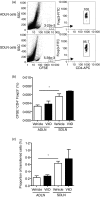1,25-dihydroxyvitamin D3 enhances the ability of transferred CD4+ CD25+ cells to modulate T helper type 2-driven asthmatic responses
- PMID: 20059575
- PMCID: PMC2878463
- DOI: 10.1111/j.1365-2567.2009.03222.x
1,25-dihydroxyvitamin D3 enhances the ability of transferred CD4+ CD25+ cells to modulate T helper type 2-driven asthmatic responses
Abstract
The severity of allergic diseases may be modified by vitamin D. However, the immune pathways modulated by the active form of vitamin D, 1,25-dihydroxyvitamin D(3) [1,25(OH)(2)D(3)], are yet to be fully elucidated. In this study, naturally occurring CD4(+) CD25(+) cells from the skin-draining lymph nodes (SDLN) of mice treated with topical 1,25(OH)(2)D(3) had an increased ability to suppress T helper type 2 (Th2) -skewed immune responses. CD4(+) CD25(+) cells transferred from mice treated with topical 1,25(OH)(2)D(3) into ovalbumin (OVA) -sensitized mice challenged intranasally with OVA 18 hr later, significantly suppressed the capacity of airway-draining lymph node (ADLN) cells to proliferate and secrete cytokines in response to further OVA stimulation ex vivo. The CD4(+) CD25(+) cells from 1,25(OH)(2)D(3)-treated mice also reduced airway hyperresponsiveness and the proportions of neutrophils and eosinophils in bronchoalveolar lavage fluid (BALF). To test the effect of 1,25(OH)(2)D(3) on cells able to respond to a specific antigen, CD4(+) CD25(+) cells were purified from the SDLN of OVA-T-cell receptor (TCR) transgenic mice treated 4 days earlier with topical 1,25(OH)(2)D(3). CD4(+) CD25(+) cells from OVA-TCR mice treated with 1,25(OH)(2)D(3) were able to alter BALF cell content and suppress ADLN responses to a similar degree to those cells from non-transgenic mice, suggesting that the effect of 1,25(OH)(2)D(3) was not related to TCR signalling. In summary, topical 1,25(OH)(2)D(3) increased the regulatory capacity of CD4(+) CD25(+) cells from the SDLN to suppress Th2-mediated allergic airway disease. This work highlights how local 1,25(OH)(2)D(3) production by lung epithelial cells may modulate the suppressive activity of local regulatory T cells.
Figures







Similar articles
-
Topically applied 1,25-dihydroxyvitamin D3 enhances the suppressive activity of CD4+CD25+ cells in the draining lymph nodes.J Immunol. 2007 Nov 1;179(9):6273-83. doi: 10.4049/jimmunol.179.9.6273. J Immunol. 2007. PMID: 17947703
-
Topical 1,25-dihydroxyvitamin D3 subverts the priming ability of draining lymph node dendritic cells.Immunology. 2010 Nov;131(3):415-25. doi: 10.1111/j.1365-2567.2010.03315.x. Immunology. 2010. PMID: 20561084 Free PMC article.
-
Resolution of airway inflammation and hyperreactivity after in vivo transfer of CD4+CD25+ regulatory T cells is interleukin 10 dependent.J Exp Med. 2005 Dec 5;202(11):1539-47. doi: 10.1084/jem.20051166. Epub 2005 Nov 28. J Exp Med. 2005. PMID: 16314435 Free PMC article.
-
Immune-modifying properties of topical vitamin D: Focus on dendritic cells and T cells.J Steroid Biochem Mol Biol. 2010 Jul;121(1-2):247-9. doi: 10.1016/j.jsbmb.2010.02.034. Epub 2010 Mar 6. J Steroid Biochem Mol Biol. 2010. PMID: 20211255 Review.
-
Regulatory T cell migration during an immune response.Trends Immunol. 2012 Apr;33(4):174-80. doi: 10.1016/j.it.2012.01.002. Epub 2012 Feb 2. Trends Immunol. 2012. PMID: 22305714 Free PMC article. Review.
Cited by
-
The Association between Vitamin D, Interleukin-4, and Interleukin-10 Levels and CD23+ Expression with Bronchial Asthma in Stunted Children.Biomedicines. 2023 Sep 15;11(9):2542. doi: 10.3390/biomedicines11092542. Biomedicines. 2023. PMID: 37760982 Free PMC article.
-
Modulation of the immune system by UV radiation: more than just the effects of vitamin D?Nat Rev Immunol. 2011 Aug 19;11(9):584-96. doi: 10.1038/nri3045. Nat Rev Immunol. 2011. PMID: 21852793 Review.
-
Invariant NKT cell defects in vitamin D receptor knockout mice prevents experimental lung inflammation.J Immunol. 2011 Nov 1;187(9):4907-12. doi: 10.4049/jimmunol.1101519. Epub 2011 Sep 23. J Immunol. 2011. PMID: 21948983 Free PMC article.
-
Vitamin D and allergic disease: sunlight at the end of the tunnel?Nutrients. 2012 Jan;4(1):13-28. doi: 10.3390/nu4010013. Epub 2011 Dec 28. Nutrients. 2012. PMID: 22347615 Free PMC article. Review.
-
1,25-Dihydroxyvitamin D3 protects obese rats from metabolic syndrome via promoting regulatory T cell-mediated resolution of inflammation.Acta Pharm Sin B. 2018 Mar;8(2):178-187. doi: 10.1016/j.apsb.2018.01.001. Epub 2018 Feb 1. Acta Pharm Sin B. 2018. PMID: 29719778 Free PMC article.
References
-
- Miyara M, Wing K, Sakaguchi S. Therapeutic approaches to allergy and autoimmunity based on Foxp3+ regulatory T-cell activation. J Allergy Clin Immunol. 2009;123:749–55. - PubMed
-
- Gorman S, Kuritzky LA, Judge MA, Dixon KM, McGlade JP, Mason RS, Finlay-Jones JJ, Hart PH. Topically applied 1,25-dihydroxyvitamin D3 enhances the suppressive activity of CD4+ CD25+ cells in the draining lymph nodes. J Immunol. 2007;179:6273–83. - PubMed
-
- Gorman S, Tan JW-Y, Yerkovich ST, Finlay-Jones JJ, Hart PH. CD4+ T cells in lymph nodes of UVB-irradiated mice suppress immune responses to new antigens both in vitro and in vivo. J Invest Dermatol. 2007;127:915–24. - PubMed
-
- Schwarz T. 25 years of UV-induced immunosuppression mediated by T cells – from disregarded T suppressor cells to highly respected regulatory T cells. Photochem Photobiol. 2008;84:10–18. - PubMed
Publication types
MeSH terms
Substances
LinkOut - more resources
Full Text Sources
Molecular Biology Databases
Research Materials

